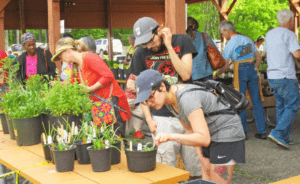## A Hollywood Dream on Hold: Paramount Hudson Valley Loses Key Funding The future of a project once hailed as a beacon of artistic revival in the Hudson Valley hangs precariously in the balance. Paramount Hudson Valley, envisioned as a sprawling film and television studio complex, has been dealt a blow after losing a crucial federal grant. This setback raises serious questions about the project’s viability and the long-term impact on the region’s cultural and economic landscape. Was this just a temporary hurdle, or is this the beginning of the end for a dream that promised to bring Hollywood magic to the Hudson Valley?
Paramount Hudson Valley’s Fight for Survival

The recent withdrawal of a federal grant by the National Endowment for the Arts (NEA) has sent shockwaves through the Paramount Hudson Valley Arts, a cornerstone of the Peekskill community. The grant, originally earmarked for two culturally significant performances – Cirque Zuma Zuma celebrating African traditions during Black History Month and an Argentine tango performance during Hispanic Heritage Month – has been terminated due to the NEA’s stated shift in funding priorities. Abigail Adams, executive director of Paramount Hudson Valley Arts, expressed her disappointment, stating that the agency’s new focus on “fostering AI competency, assisting with disaster recovery, and making America healthy again” comes at the expense of grassroots arts organizations like her own.
Adams highlighted the potential impact of this decision, noting that “dozens of arts nonprofits large and small all across the country just received similar emails terminating their NEA grants.” This wave of budget cuts, she suggests, is part of a larger movement to eliminate the NEA entirely, a sentiment echoed by national press reports of staff resignations and internal turmoil within the agency. In response, major advocacy groups like Americans for the Arts are urging all impacted organizations to appeal the decision.

Appeal Process and Potential Outcomes
Paramount Hudson Valley Arts is indeed pursuing an appeal, recognizing the time-sensitive nature of the situation. “Appeals take time, and there is no guarantee that we will ever get the grant we were awarded months ago and were counting on this year,” Adams acknowledged. This uncertainty underscores the precarious financial position of many arts organizations, particularly those reliant on government funding.
While the appeal process is underway, the organization is actively mobilizing its community to support its mission. Adams emphasized the importance of community engagement, stating, “If the federal government won’t fund inclusive arts programming that celebrates all of us, then it’s up to all of us – patrons and neighbors, business and civic leaders – to do whatever we can to make sure this kind of community-focused programming can survive at the Paramount.”

Community Mobilization Efforts
The Paramount Hudson Valley Arts is launching a multifaceted campaign to rally support from its community. This includes a renewed focus on individual donations, corporate sponsorships, and fundraising events. The organization is also leveraging its online presence to engage with supporters and raise awareness about the challenges facing arts organizations like its own.
Adams recognizes the power of grassroots activism in securing funding for arts programs. “We believe that the arts are essential to a thriving community,” she stated. “They enrich our lives, foster creativity, and connect us to our shared humanity.” She calls on the community to join their fight by donating, volunteering, and advocating for the arts.

Challenges for Grassroots Arts Organizations
The Paramount Hudson Valley Arts’ predicament highlights the broader challenges faced by grassroots arts organizations in securing funding. These organizations often lack the resources and connections of larger institutions, making them more vulnerable to funding cuts and budget constraints. Furthermore, the NEA’s recent shift in priorities, driven by political considerations, underscores the precariousness of government funding for the arts.
This situation raises critical questions about the role of government in supporting artistic expression and cultural diversity. Experts argue that public funding for the arts is essential for maintaining a vibrant cultural landscape and fostering innovation. Without adequate support, grassroots arts organizations may struggle to survive, depriving communities of access to vital cultural experiences.
The Future of Inclusive Arts Programming
Cultural Diversity and Representation
The Paramount Hudson Valley Arts’ commitment to showcasing diverse artistic traditions is crucial for fostering cultural understanding and inclusivity. The organization’s canceled performances, celebrating African and Argentine cultures, exemplify the importance of representing a wide range of voices and perspectives in arts programming. Inclusive arts programming not only celebrates cultural diversity but also challenges stereotypes and promotes empathy and understanding.
Experts emphasize that inclusive arts institutions are essential for reflecting the richness and complexity of our society. They provide platforms for marginalized communities to share their stories, express their creativity, and build bridges of connection across cultural divides. Without such representation, the arts risk becoming a homogeneous and exclusionary space.
Community Support: A Vital Lifeline
The Paramount Hudson Valley Arts’ appeal for community support underscores the vital role that individuals and organizations play in sustaining arts programming. In an era of declining government funding, grassroots organizations rely heavily on the generosity and engagement of their communities to thrive.
- Individual donations provide essential financial support for artistic projects, allowing organizations to pursue ambitious and innovative programming.
- Corporate sponsorships can help offset operational costs and provide resources for arts education and outreach initiatives.
- Volunteerism is crucial for providing hands-on support for a wide range of tasks, from marketing and fundraising to technical assistance and event staffing.
- Diversifying funding sources: Exploring new avenues for funding, such as crowdfunding campaigns, philanthropic partnerships, and creative revenue streams, can help mitigate reliance on government grants.
- Building strong community partnerships: Collaborating with local businesses, educational institutions, and other community organizations can create synergistic opportunities for funding, programming, and audience development.
- Embracing digital platforms: Leveraging online platforms for fundraising, marketing, and audience engagement can expand reach and build a wider base of support.
Community engagement goes beyond financial contributions. It encompasses active participation in arts events, advocacy for arts funding, and a shared commitment to supporting the artistic vitality of the community.
Ensuring Long-Term Viability
The challenges facing the Paramount Hudson Valley Arts and other grassroots organizations highlight the need for innovative solutions to ensure the long-term viability of inclusive arts programming.
By embracing these strategies, arts organizations can navigate the evolving landscape of funding and continue to provide essential cultural experiences for their communities.
Conclusion
The loss of the federal grant is a significant blow to Paramount Hudson Valley, potentially jeopardizing its ambitious revitalization plans and casting a shadow over the future of the historic theater. The article meticulously outlines the grant’s intended purpose, the economic benefits it promised, and the compelling case Paramount presented for its restoration. However, the decision highlights the fierce competition for federal funding and the complex factors influencing its allocation.
This setback underscores the precarious financial landscape faced by many cultural institutions, particularly those struggling to revitalize and adapt to evolving audience needs. It raises crucial questions about the role of public funding in supporting local cultural treasures and the potential consequences of insufficient support. As Paramount Hudson Valley navigates this challenge, its success will depend not only on securing alternative funding sources but also on fostering strong community engagement and demonstrating the enduring value it brings to the region. This situation serves as a stark reminder that preserving the cultural heritage we cherish requires sustained effort and a collective commitment to its future.

